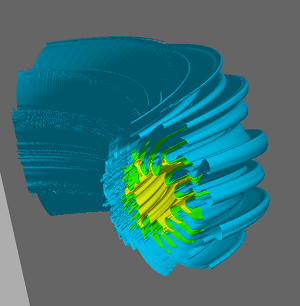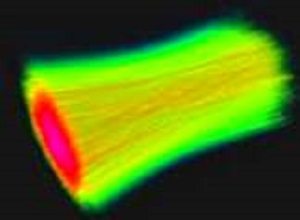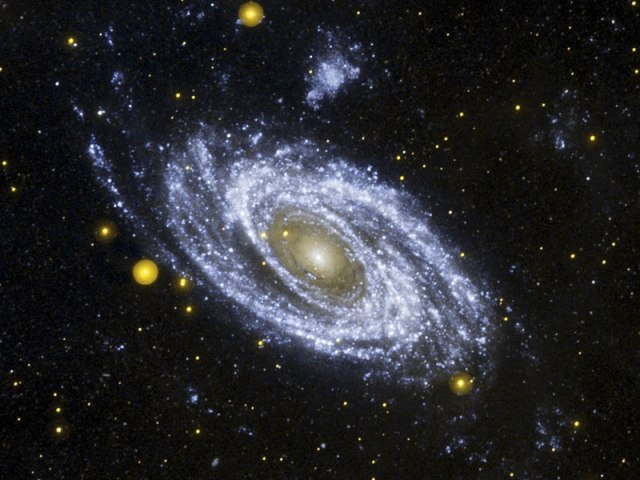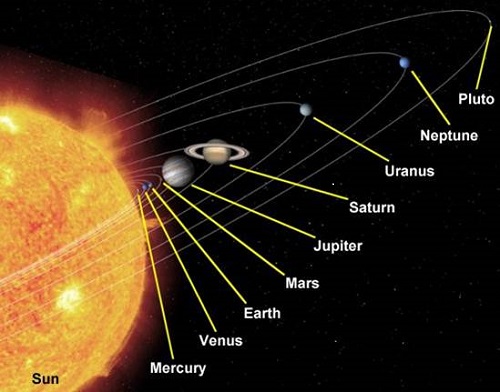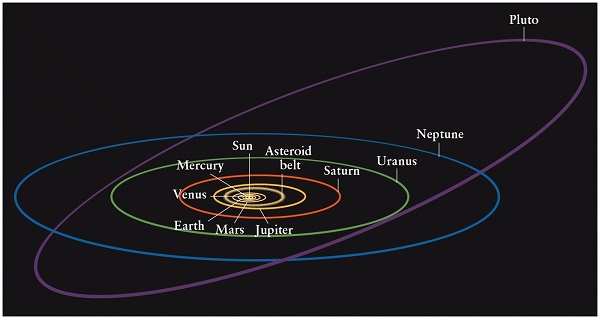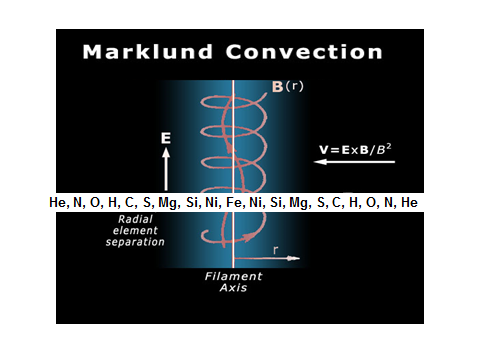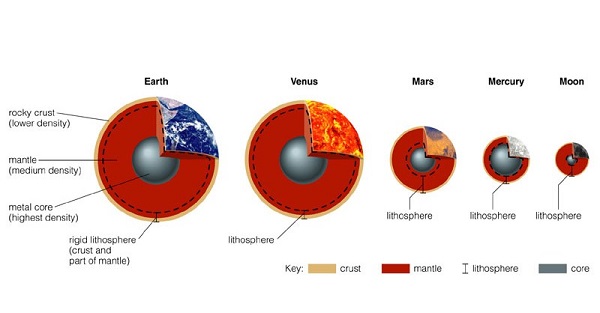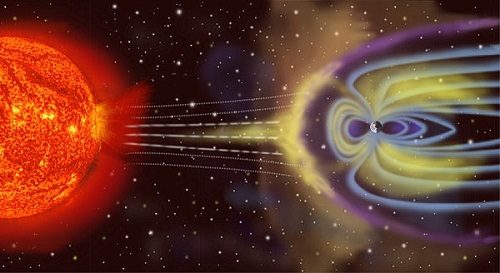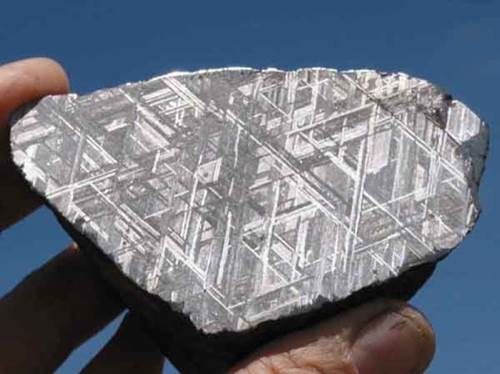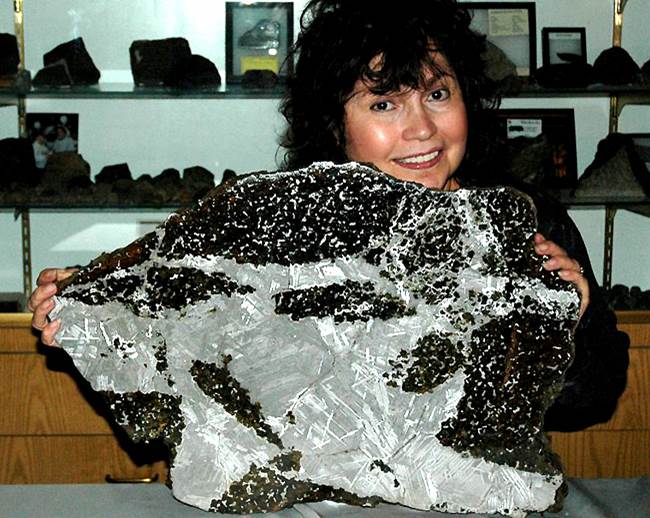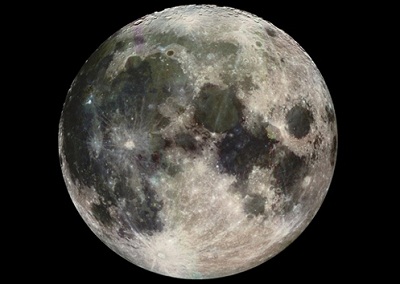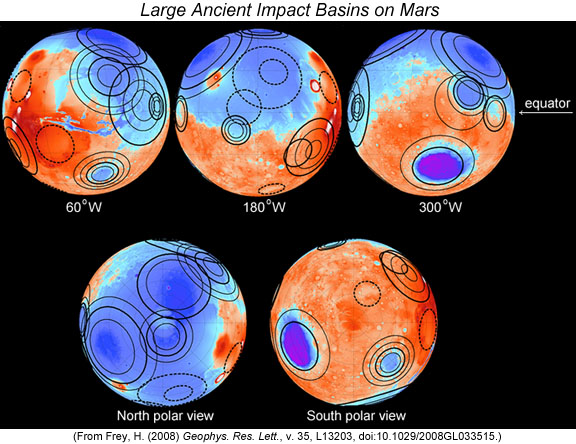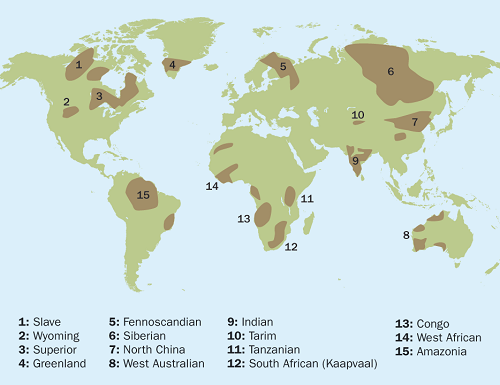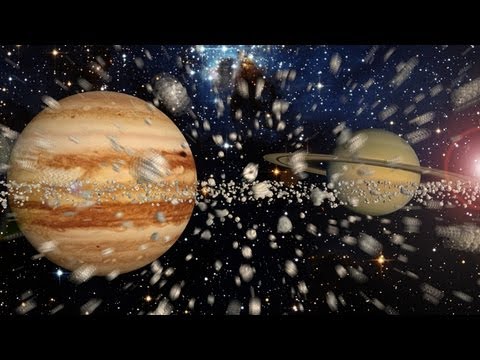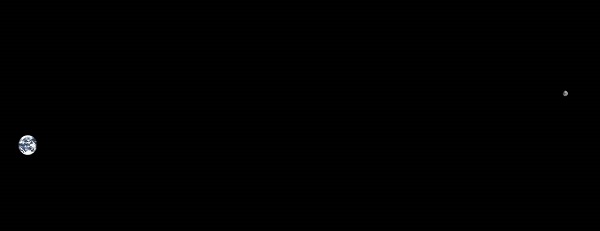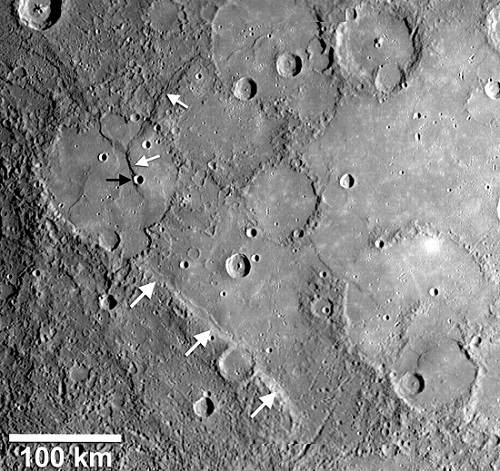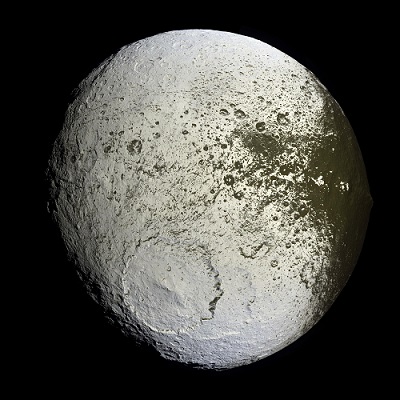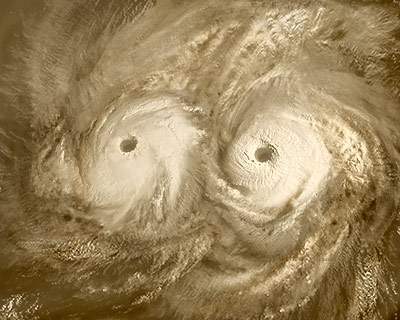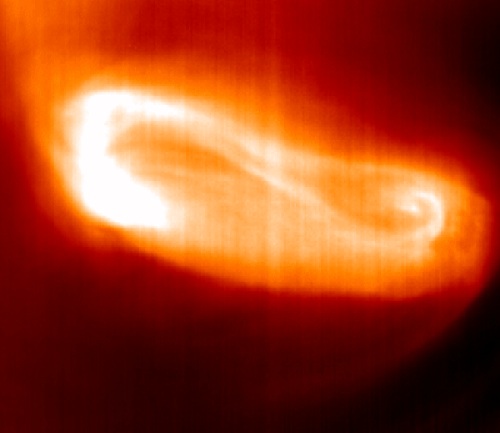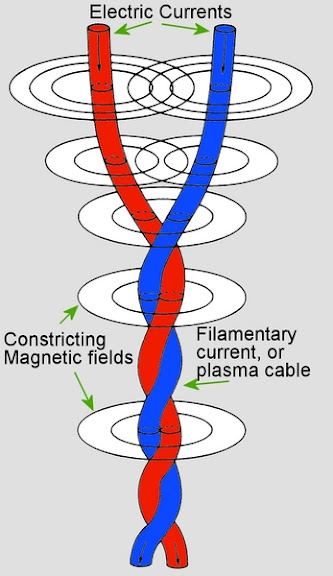Explanations and Interpretations
There are two main theories regarding the formation of our solar system. One is gravitational and the other is, basically, electrical, or electromagnetic -- to be more precise. The gravitational model states that billions of years of accretion, or 'coming together' of dust particles, due to gravitational attraction, formed the planets as well as the sun. The electromagnetic model states that plasma pinches formed the stars and planets. This is explained in the Plasma Model. Plasma filaments themselves can, and do, fragment into what would remind one of a cable with a lot of wires in it.
Sometimes a plasma filament itself becomes unstable, and breaks up into several smaller filaments with a main central core.
The magnetic field will keep these fragmented filaments somewhat together, as we can see in spiral galaxies.
In the above galaxy there are two main filaments which have interacted. Each, however, has fragmented itself so that you see the splaying out at the outer ends. If a filament is acting as a whole and is disturbed and pinches, a star is formed:
But if the filament has fractured internally, the pinch, starting from the outside, forms little balls before the main inside filament feels the pinch and lights up, forming a star. On a smaller scale, such as our solar system, essentially the same thing happened. When the 'cable' filament pinched, the outer sub-filament reacted first, forming a ‘ball’ of some sort at the pinch. The pinching effect progresses inward, with a series of ‘balls’ beginning to rotate about the center. These 'balls' are cool, not hot and molten. As the pinch reaches the middle, the electric current of the main plasma filament itself is becoming condensed to the core. As the core reacts to the pinch, high electric current causes it to remain plasma, and it goes into arc mode. The earth, as well as the other planets, are these ‘balls’ which formed. And they all formed before the sun lit up.
What is very important in the Plasma Model is something called Marklund Convection. Marklund Convection is the term used for the way plasma filaments will sort elements. The elements that are the most easily ionized (can get electrons stripped off them) end up in the center and the other elements are layered toward the outside so that the hardest ones to ionize are on the outside. The tendency is for the heaviest elements to be in the interior although this is not an inviolable rule.
The gravitational explanation for the structure of planets is that bits and pieces of the original material of the universe gradually, via gravitational attraction, started to cling together, and by attracting more and more nearby pieces, formed the bodies of the solar system. In this model, the heavy elements are seen as gravitating towards the center of these bodies as they formed. These bodies are then said to have started as immensely hot, molten masses which then cooled over very long periods of time. The electromagnetic explanation for the structure of the planets is that they were formed as a series of plasma pinches which worked their way in from the outside of a much larger (internally fractured) plasma filament, and that each of the planets then exhibited the effects of Marklund Convection in their layering. The last part to pinch was the innermost, which then lit and became our sun. Marklund Convection, if this model holds, would also predict the relative sizes of the nickel-iron cores of the planets in relation to their place in the solar system. Mercury, being the closest to the center, would have the largest core relative to its size and the cores would then decrease in relative size to the planet the farther out the planet is from the sun. We hold with the electromagnetic model because it does predict exactly what we see.
Above is a comparison of the inner planets with their cores. Obviously, Mercury's core is the largest relative to the size of that tiny planet. The one thing that could be corrected above is that we have recently found that Venus' core is larger than ours, and so somewhat larger than pictured above. In the illustration below, the size of the earth is shown in comparison to the outer planets. It does appear as though the planets themselves demonstrate the effects of Marklund Convection with regard to the size of their iron-nickel cores in relation to the rest of each individual planet.
The result of this type of planet formation is that the planets did not start out as molten masses, but as relatively cool bodies which then heated from their interiors due to the concentration of radioactive materials in their cores. This means that the planets did not start as hot, molten masses, but as relatively cool bodies that heated from the inside. This, in turn, would explain why Venus, Jupiter, Saturn, and Neptune all indicate they are giving off more heat than they get from the sun. As mentioned in each of the planet studies, each planet has its own plasma shield, or sphere,which actually dwarfs the planet.
our entire solar system is also surrounded by a plasma sphere
Given the predominance of plasma, then, in our own solar system, as well as the fact that the sun itself appears to be a plasma ball, as discussed below, the electrodynamic, or plasma, model of the solar system seems to fit the data and known physics better than the gravitational model does. The Inner Planet Catastrophe page gives the order of events that happened in the solar system. The Late Heavy Bombardment is the first major catastrophic event our solar system experienced. The main gravitational model describes and explains it this way in a BBC article:
However, if you have read the page in this study on Comets and Meteors, you will see, near the end of the page, the mention that some interesting minerals have been found in material gathered from comets and asteroids. As shown on that page:
Thus, the actual evidence suggests that there was a large planet out beyond Neptune in the past and it exploded, or was shattered. This was in the area now referred to as the Kuiper Belt. Why would this happen? And, if that planet exploded,why didn't Neptune, or Uranus? The answer lies in a twofold explanation that involves both Marklund Convection and distance from the sun. The farther out from the sun, the colder it is. That part is simple. So we can assume the outermost planet was composed of not only an extremely small nickel-iron core, but of primarily ices surrounding it. The composition of these ices would be determined by Marklund Convection. The ionization potential sequence indicates that these elements would predominate: hydrogen, oxygen, carbon, and nitrogen. Why not helium? Helium does not freeze, even at absolute zero (unless huge pressure is also applied), so there is no such thing as a helium ice. The outermost planet would then have been composed of ices involving those four elements as methane, ethane, carbon monoxide, carbon dioxide, and water. As its tiny core started heating from the radio decay of its heavier elements, the ices surrounding it would have melted, expanded (from the interior outward, causing increasing pressure under the surface), and finally exploded apart. Many of its pieces are still in orbit around the sun as either Kuiper Belt objects or comets. In contrast to this, Neptune had a much higher concentration of hydrogen which formed a huge hydrogen envelope around it which damped down any explosive tendencies in the core. This held for all four gas giants. The explosion of the outermost planet was the cause of the Late Heavy Bombardment. Pieces of ice mixed with rocks came shooting in from the outer reaches of the solar system, impacting every other body. Some of them became captured moons, sailing in so close to Saturn, or Jupiter, or Uranus, or Neptune, to be held by their gravitational fields. These moons are often in inclined orbits and are usually easily spotted as rocky and icy chunks. As Tom Van Flandern pointed out, the orbits of Kuiper Belt Objects and comets contain explosion signatures. If, as the above gravitational model stated, Jupiter, Saturn and Neptune were all involved in some kind of interaction that sent Neptune careening into the outer solar system, several questions come to mind:
In other words, it is important to examine all the data and not simply try to make up stories because of preconceptions. In 1995, astrophysicist Tom Van Flandern wrote the following in an article on trans-Neptunian Asteroids
Five years later, Van Flandern wrote "The Exploded Planet Hypothesis 2000," in which he stated the following: Where It Began – the Titius-Bode Law of Planetary Spacing
Toward the end of the article, Van Flandern turns his attention from the Asteroid Belt to the trans-Neptune objects, which we now recognize as Kuiper Belt Objects:
We agree with Van Flandern. Originally there was another giant planet beyond Neptune. When it exploded, some of its pieces continued in orbit around the sun at various inclinations and eccentricities. Pluto, originally thought to be a planet itself, is one of those pieces. Some pieces were large enough to have the gravitational attraction necessary to capture and hold smaller pieces, which are then called moons. If two pieces about the same size caught and held each other in a spin around each other, this is called a binary. Would this be expected from an explosion? Let's read a little more of what Van Flandern had to say:
It is this phenomena which leads to an explanation of what is really happening with "splitting comets." We agree, again, with Van Flandern's hypothesis that when a comet which has some small bodies associated with it gravitationally approaches the sun, enough mass melts off for the parent body to lose some of its gravitational pull, allowing the associated smaller body to drop away. This brings us back to the Late Heavy Bombardment (LHB). The planet beyond Neptune that exploded sent thousands upon thousands of its pieces careening in toward the inner solar system as well as out into space. Some did remain in orbits; some became comets; some were captured as moons by the larger planets as they passed, but a great number simply smashed into the inner planets, their moons, and the existing moons of the larger planets. Those that hit the larger planets would leave no trace because of the gas composition of those planets. Here are some pictures of evidence of the Late Heavy Bombardment which have not been too badly erased by later impact or electric events. The maria on the moon, the low areas on Mars, the early craters on Mercury, and even on Jupiter's moon, Ganymede, where some of the older craters are attributed to the LHB.
What happened on Earth at that time? Keep in mind that the explosion of the planet happened very quickly after creation itself. Atomic processes were much, much faster at that time and so radioactive heating occurred rapidly. The planet did not exist for long. It may have exploded a matter of weeks after creation or up to a year or two after. The shattered pieces, however, needed time to reach the inner solar system. Earth was probably hit about the time of Jared in Genesis, just before the birth of Enoch. This was about 1250 years after Creation; just about the amount of time that would be needed for material from beyond Neptune to impact the inner planets. So while the Earth's land itself rose on day three of creation, the effects of the LHB were not felt for a little over a thousand years later. The impacts which hit the earth may well have hit on the ocean side (there was only one continent at that time), which would have blunted their force somewhat. But the force of the impact was still enough to cause the rising of great plumes of magma under the land which then partially hardened. We call these magma plumes which are under the continents today "cratons." The Bible refers to them as "pillars." An artist's reconstruction of what the pillar under Iceland looks like is on the left below. The placement of other cratons today is shown on the map on the right.
There is something fascinating to note about the LHB and where it hit on the earth and our moon. Our moon is in sync with the earth, so we always see the same side of it. Before the continents were divided, they were all on one side of the world as a single landmass, Pangea. When that massive amount of hits occurred, for the cratons to be formed, the earth had to be hit on the ocean side, sending the shock waves through the earth. The moon got hit on the side that we see. There are no maria on the other side of the moon. This means that anyone on earth would have seen the moon being hit. Interestingly, we have some ancient stories that talk about rocks being thrown at the moon and the moon, then, "changing its face." The most graphic of these stories comes out of the South Pacific Islands -- but remember that everyone was on the one continent when it happened; it was not a matter of people in the south Pacific seeing it, but of people who lived there after remembering the stories. Here is an artist's illustration of the intensity of the Late Heavy Bombardment material that came in past Saturn and Jupiter to the inner solar system:
Now, look back at what the distances in the solar system actually look like:
Now look at a picture taken from space of the Earth and our moon:
When we consider the number of impact sites from the LHB that we see on Mercury, our moon, Mars, and other places still, and we realize how far those pieces had to come, and how spread out they must have been, the only conclusion possible is that the planet that was once, for a short time, beyond Neptune was extremely large. There is one other thought which comes from Van Flandern regarding comets: "only very recent explosions can produce comets that would remain visible today." He was not a young earth creationist. Internal Heating of the Planets Because of Marklund Convection, the cores of each planet were undergoing heating from the radio decay of their heavy elements. The four gas giants did not have too much of a problem for two reasons: first because their relative cores were so small compared to the entire planet, and second, each of them had --and still has -- very thick layers of gases surrounding them which buffered any explosive tendencies. Things were a little different in the inner solar system. Mercury did not have a problem because it contained no water in its rocks. Oxygen and hydrogen, being much more plentiful farther out, were not there. This, plus its small size, allowed Mercury to simply give off any excess heat in its early life. There may have been a little expansion and cracking. What we also see is evidence of subsequent contraction in the form of what is called lobate scarps.
Venus, Earth and Mars were developing potential catastrophes, however. All three planets were having water driven out of their mantle rocks which was then starting to force its way to the surface. Interestingly, the Bible indicates this as early as day three, when it mentions that water was coming up from under the ground to water the earth. Water does not go up if it is not under pressure, so it was being pressured. And pressure means heat. A few days later, by the time of the Garden of Eden, enough water was coming up in that one area to form the headwaters of four major river systems. Still, these three planets were holding.... There was another planet and its moon, however, between Mars and Jupiter, which was not so fortunate. Both this planet and its moon exploded, but at different times. The first explosion was of the mantle of the planet, the second of its core, and then, later, its moon also exploded. Like its big brother out past Neptune that had exploded a couple of thousand years earlier, this planet sent its pieces scattering in all directions. Two of them were captured by Mars and became its moons -- little rocks that don't look like moons at all. A number of its pieces were captured by Jupiter and became some it its moons. More ended up strung out in Jupiter's orbit and became what we call the Trojan asteroids. The Asteroid Belt and the three asteroid groups that are separate from it are also from these explosions. There is a reason the Asteroid Planet blew up but Mars, Earth, and Venus didn't. To find that reason we have to go back to Marklund Convection. In the same way different elements were sorted in the formation of the individual planets, they were also sorted in terms of the entire solar system. Venus had some water. Earth has more. Mars, being smaller, had a lesser amount but plenty in terms of its percentage. The peak of the hydrogen-oxygen mix which forms water was at the point where the Asteroid Planet was. We know from bits and pieces of it which have hit Earth that it contained at least 20% water in its mantle. Compare that with the probablility that the Earth's mantle would not have contained more than 5% water in its youth. (It is still about 2% water, which is enough to fill the oceans again.)
Why didn't the Asteroid Planet explode all at once? The answer lies in the chemical composition of the mantle, first of all. Asteroids from that part of the planet are the stony meteorites when they land on Earth, and show an excess of Magnesium 26. Magnesium 26 is radiogenic, which means it is the end product of the radio decay of Aluminum 26. (Aluminum ions are the right size to be trapped in the silicate latices, and are often found in silicates on earth.) .Because Aluminum 26 has a very short half life, the decay process was fast and therefore the heating was rapid. As The Cambridge Atlas of Astronomy states, "Heat from short-period radioactive elements such as aluminum 26, would be sufficient to melt bodies of a size greater than ten kilometers [about 6.25 miles]." Because the meteorites from the mantle have up to 20% water in them, we know the mantle did as well. The mantle was heating quickly, the water was being driven out, the rocks were expanding and then the mantle blew. In atomic time, this first explosive blowup occurred about 750 million years ago. When this is corrected to orbital time, the initial breakup occurred about five years before Noah's Flood, or about 3555 BC. It was the impacts from the meteorites from this which initiated the Flood. The pressure of the water under our crust was so great by that time because of the heating of our own interior driving water out of our mantle's rocks, that the effect was something like a pin pricking a balloon. The Bible states in Genesis 7:11 that all the springs/fountains of the great deep burst forth/out. The Hebrew word translated "burst" is a word denoting a violent bursting forth. This is exactly what would be expected. Mars was also hit and its waters burst out, flooding the entire northern surface of the planet. Venus was hit and the fact that a large amount of water burst out is evidenced today by the large amount of deuterium in its atmosphere. Pieces of the exploded mantle also hit our moon and Mercury as well, leaving impact craters there. Although the mantle was now gone for the most part, the core of the planet remained in orbit, although that orbit may well have been changed somewhat by the explosion of the mantle. The core was still heating with its long half-life radioactive elements and this meant it was expanding. There was still some water (easily 2% or more) and other elements in there. The surface was relatively cool, so it was under increasing strain from the melting going on inside. Not only was the water super-heating, but when rocks melt they expand by about 10%. The core finally exploded, too. We know from signatures on those nickel-iron meteorites from the core which have hit earth that the primary cause was the heating of the core. However there may have been some contributary causes as well. The core may have been hit by one of its own asteroid pieces from the mantle. It may have swung close enough to Jupiter to react to the gravitational field. Given the heating and the water there, perhaps none of that was necessary. What we do know from dating, is that this secondary explosion occurred about 255 - 250 million atomic years ago. When this is corrected to orbital dating, we are within a few years of the Babel catastrophe. We have evidence of a very large impact at that time in what is now Antarctica. That hit sent a large shock wave through the earth which resulted in the outpouring of the Siberian Traps. That left the moon of the planet alone in orbit with a lot of pieces of its original mother body. Because it did not have as much water as the planet, and probably not as much radioactive material (since it was smaller) it took more time to react. It finally exploded, too, for the same reasons: internal heating. There was enough water for that. Pieces of that moon which have hit the earth which have hit the earth as carbonaceous meteorites inform us that the moon exploded 70 - 65 million atomic years ago. That may sound familiar to those who know the 65 million year ago date is connected with the extinction of the dinosaurs. When it is corrected to orbital time, it happened shortly before the time of Peleg, when the continents were divided. The standard explanation for the Asteroid Belt is that it is made up of primordial material which, at least in part due to Jupiter's gravitational influence, never was able to come together as a planet. This interpretation does not explain why there are three basic types of asteroids -- the nickel-irons which are associated with planetary cores, the stony type which are associated with crusts and mantles, and the carbonaceous type, which is associated with a moon. If the Asteroid Belt is indeed the remains of an exploded planet and its moon, there is a major question to be answered: where did all the mass go? Thousands of asteroids have been discovered, but all put together, their mass is only about 1/1000 the mass of Earth. Our moon has ten times more mass than that! Once again, Van Flandern has some excellent thoughts on this, as recorded in "The Exploded Planet Hypothesis 2000."
This explanation does not even take into account the pieces that hit other planets and moons, or which simply disappeared into space or into the sun or a gas giant. It would actually be quite astonishing if we found a much greater amount of mass in the Asteroid Belt!
Saturn's moon Iapetus gives us some very interesting thoughts. First, again from Van Flandern, referring to the explosion of the Kuiper Belt Planet:
The problem with this explanation is that we do not see the same effect on other slowly rotating moons. The fact remains, however, that it is the 'burnt' or dark side of Iapetus on which the ridge system is broken up, and this could have been a result of such a blast. The note under #2 just below adds something interesting. Another explanation for the dark coloration is that, since that side faces the sun when it is on sunward side of Saturn (about 40 days at a time), the sunlight might be causing volatile ices on the surface of the moon to evaporate, leaving only the dark material behind. This explanation would seem fine if the ridge were not also disrupted on the dark side. That does seem to suggest something a bit more dramatic happening. There are a number of hypotheses regarding how that strange ridge was formed, as well. The two most logical explanations are
NOTE: The earth's rotation rate is 24 hours, but we were hit on only one side during the LHB. This certainly allows Iapetus to have the slightly faster rotation rate and still get hit on only one side. A summary of solar system catastrophes (as related to the inner planets, since the outer planets are gas and don't show impacts) might help with putting all this together. There are five theories current in the gravitational model regarding the formation of our moon. As the short page linked explains, only the theory regarding an impact tearing material away from Earth which later condensed together to form our moon seems to be plausible in this area of thinking. This theory, however, does not explain the moon's nearly circular orbit around the earth. By way of contrast, the electromagnetic model sees the moon formed at the same time as Earth and in the same way: the pinching of an internally fragmented plasma filament. One argument against the idea that the moon was formed at the same time the Earth was, is that the moon rocks have a different composition from Earth rocks. However, this would be expected as a result of Marklund Convection. The Venus Double Polar Vortex What we see:
These double-lobed vortex structures may give us a hint as to why Venus' atmosphere is whirling like it is. The atmosphere has a 4 day rotation period at the equator and a two day rotation period at the poles. The additional clue we need is given by the strike-rate for lightning (25 times a second), the glowing arcing surface and the plasma phenomena encountered by probes from a height of 12.5 km down. There is an intense electrical environment associated with the planet. In such an environment Birkeland currents as seen in plasma physics will play a big part. Birkeland currents usually come in pairs and twine around each other like this:
The spiral ice caps on Mars may well be the results of electrical/magnetic forces driving the atmosphere. We see the same sort of spiral pattern on Venus, as shown above. Why does it radiate more heat then it gets from the sun?
It has been stated that the retrograde orbits of several hot Jupiters "calls into question the theories about the formation of planetary systems." We agree. The concept that these planets are simply accretions of gas and dust in a flat disk around a star does not work physically. Suggestion: Hot Jupiters may form by explosive emission from a star that has undergone electrical stress, like a capacitor exploding. That would account for retrograde motion and orbits at high angles to the star’s rotation axis. Alternately, capture of a rogue planet may have occurred. It has also been noted that "Hot Jupiter’s with orbit periods of half a day around their star occur with stars of mass less than 1.25 solar masses. These planets do not accord with standard theory." Suggestion: These extremely rapid revolution rates mean they are quite close to their star. Thus, this may also be an indication that they were formed by explosive expulsion from the star itself.
|

